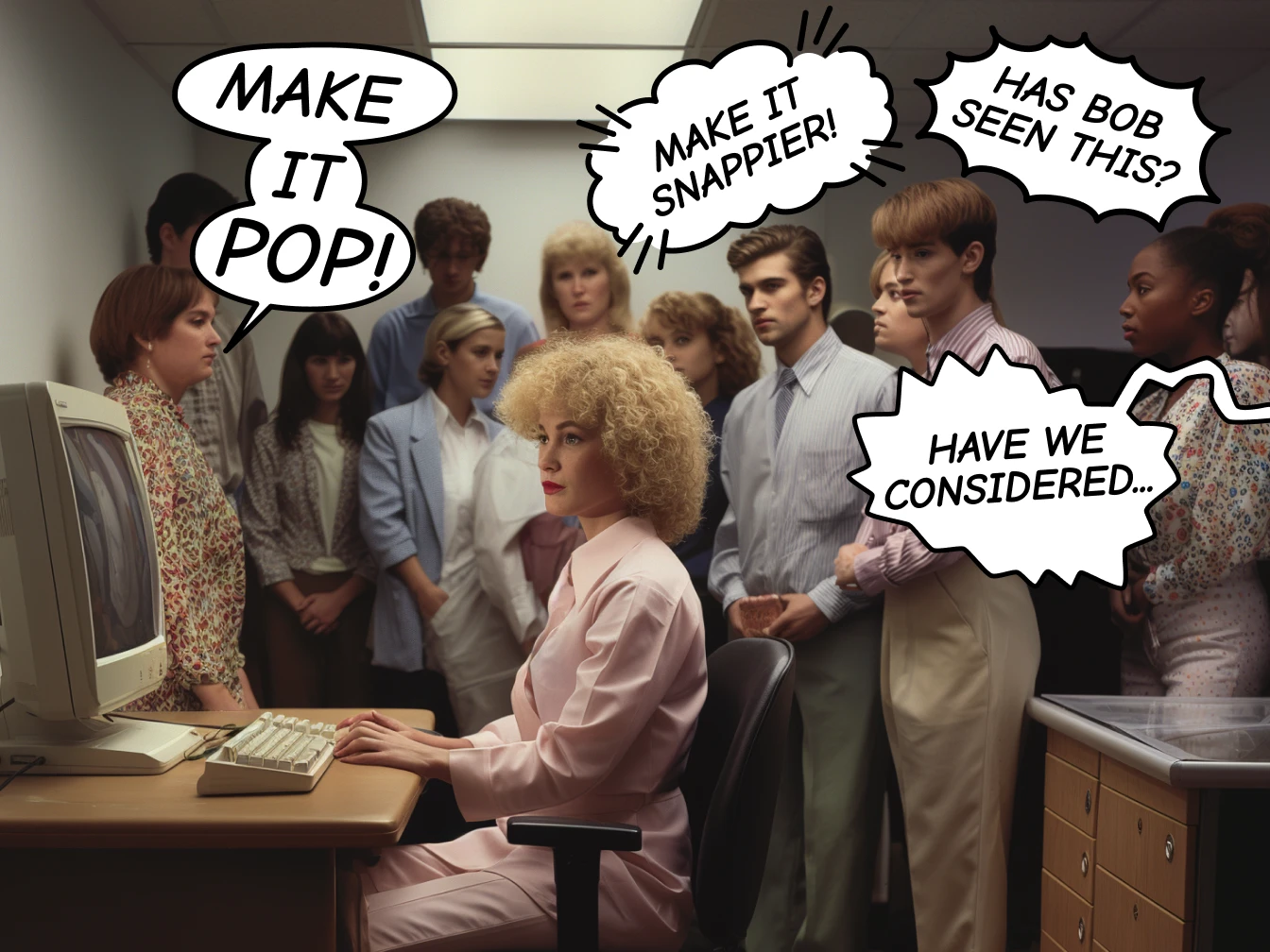Opinions
10 min read
Collaboration
is a hoax
Feedback, comments, reactions, and hand-offs: this is order giving, not working together, and there's way too much of it.
Collaboration is a hoax
Mike Stilling
Summary
The article criticizes the excessive emphasis on collaboration in modern workplaces, pointing out that it often leads to inefficiencies and dissatisfaction among employees. It argues for the implementation of smaller, focused teams and more streamlined processes as a means to enhance productivity and empower the individuals who actually execute the work.

In this article:
The modern workplace is saturated with “collaboration.” Our job interviews are peppered with questions about our collaboration skills, and our promotions hinge on our ability to work well with others. We have a plethora of tools that claim to enhance our collaborative efforts. But, what if this focus on multi-player productivity is a hoax?
Over the past three years, I’ve worked for companies focused on creating software that improves the way we work together. One fact has become abundantly clear: the problem isn’t collaboration—it’s people, and how many of them are involved.
No matter what system or process is implemented, the unpredictable nature of human behavior remains an impossible factor to account for.
Collaboration isn’t really collaborative
Before we delve deeper, it’s important to define what we currently mean by collaboration. By its very definition, collaboration is the act of working together to produce or create something. However, in today’s workplace, it’s often synonymous with giving, receiving, and addressing feedback, planning and delegating tasks, sharing ideas, and communication in general.
How we define collaboration is part of the problem. How often do we need more feedback, more ideas, or more discussion around our daily tasks? Most of these interactions are one-way streets—where one person (or many people) dictates what should be done (the say’er), and another person actually does it (the do’er).
There are loads of people talking about the work and few actually doing it
In this scenario, the do’er is left to create on their own, which by definition, isn’t collaborative. This is the heart of the “collaboration” issue. There are loads of people talking about the work and few actually doing it—which is the exact opposite of what collaboration should be.
Misaligned priorities
People who do the work have to be experts in their field and concentrate to get things done. Their paycheck depends on their ability to “do”. But, the work is just part of the job. They are also responsible for how fast a project is completed, how well it’s done, and whether it succeeds or fails.
Because of this, a person who talks about doing stuff and a person who actually does it won’t see things the same way. For example, even if almost all of a team uses a tool to manage a project and sticks to a schedule, a higher-up can still give blocking feedback at the last second, saying they were too busy before.
How easy is it for this boss to blame the builder when a project then goes haywire? If the schedule gets delayed, it’s the do’er’s fault for not working quick enough. If things turn out bad, it’s because the do’er didn’t adequately follow instructions. It sounds harsh, but it happens all the time.
Unfounded feedback
Builders play a crucial role but often don’t have the final say due to the company’s structure and culture. Often, higher-ups and stakeholders give blocking input on areas they do not understand.
Should we value feedback from someone who doesn’t know the front-end from the back? How can we feel comfortable challenging suggestions like this? These are important questions to consider. 🤨
Eliminated ownership
Feedback can be unhelpful when it comes from those lacking technical understanding. Designers are all too familiar with vague requests like “Make it pop!”.

This leaves the task of interpreting feedback and seeking clarity to those who are doing the work. The bulk of the building process has become about deciphering and accurately interpreting an array of ill-defined ideas. In this situation, collaboration becomes a self-fulfilling cycle. The focus shifts from producing impactful results to accommodating everyone’s opinions.
Consequently, only small portions of everyone’s ideas, including the builder’s, are implemented. Compromises are made universally, leading to outcomes with no distinct ownership. When the result is positive, credit is often usurped. When it’s negative, blame is allocated.
No clear path forward
All of this creates yet another mess—learning from the work that was just done, which is often the responsibility of an entirely different team.
Often, the team monitoring a project’s outcomes is rewarded for its success, even though they are merely regurgitating data from an analytics tool. These analytics are often only available because the builder added and configured them.
In essence, all of this leaves the do’er, the person with the most knowledge about the task, who just singlehandedly built the output, as nothing more than a pair of hands for less familiar say’ers. This individual is then left in the dark, waiting for the next task to come through, while their own thoughts, opinions, and role are ignored.
Job dissatisfaction
Is it surprising that technical IC’s turnover rate is higher than directors? Let’s think about why they pick their field. Learning to build something is a big personal investment.
Usually, this choice comes from a strong interest and pleasure in the building process. Many aspects of knowing how to build aren’t enjoyable. Yet, as builders, we’re driven by our passion to earn a living from it.
We find ourselves in roles directed by someone who doesn’t understand even the basics of these processes
After reaching this goal, we find ourselves in roles directed by someone who doesn’t understand even the basics of these processes (and often earns more), showing no regard for the technical implications of their shallow direction. 😒
How did we get here?
The concept of collaboration has evolved over time. In the past, roles like design and front-end development were distinct due to technological limitations. As organizations grew, hierarchical structures seemed necessary. Nowadays, however, technological advancements allow fewer individuals to perform a broader range of tasks.
Technology has significantly progressed over the years, which should have resulted in organizational changes. The convergence of design and development roles is just the beginning. Software has become user-friendly and tools like ChatGPT are readily available. For instance, let’s consider the ease of building a marketing website today, what implications does this have?
Websites can be constructed on-the-fly using frameworks and “serverless” hosting or visual builders like Webflow. With ChatGPT, the necessity for a copywriter is questionable. If an engineer configured and integrated the analytics tool, couldn’t they could also monitor it? After all, it is their work, wouldn’t they be most interested in and accountable for its results?
In the past, an initial marketing site build would have needed a marketer, copywriter, designer, front-end developer, and back-end developer. Today, one person can easily handle such a project from end-to-end.
Processes prevent change
Software helps to uphold today’s bloated creative processses, often leading to an overload of feedback from multiple sources. 😵💫
Consider Figma. It includes a commenting feature, but why? We already share and discuss work through platforms like Zoom, Loom, Jira, and Slack, all of which allow comments. Figma allows for specific visual feedback, but is it necessary?
Software companies are business-minded, often designing their products to appeal to decision makers, not the actual users. This can result in software that caters more to managers and directors… In recent experiences, leaders outside of Sales and Engineering typically manage small teams of no more than 2-3 people. With fewer people to oversee, and less to manage, leaders have resorted to providing constant feedback.
On social platforms, views and comments drive ad views and revenue. However, in a corporate setting, a high volume of engagement typically leads to increased stress and extended timelines, not productivity.
Less collaboration, better work, more productivity
So, what’s the solution? Let’s examine the team structures behind what we consider top-notch, industry leading design.
Most leading products in terms of craft, impact, and efficiency are created by small, agile teams. It’s why VC’s are betting millions of dollars on tiny, disruptive startups. Almost every site on Awwwards… It’s the work of just one or two people. Large teams creating game-changing work are rare. Generally, smaller teams seem to deliver superior work more quickly.
Our challenge is to effect change without the authority to do so.
This doesn’t imply that layoffs are the solution, or that individual contributors can change existing organization sizes and structures. Our challenge is to effect change without the authority to do so. How can we produce higher-quality work faster, with less constraints, within a company burdened by a time-consuming hierarchy?
Build trust
Changing hierarchy and traditional patterns is tough because it involves people giving up control over our work. They’re not only worried about losing influence, but they also fear the work will fail without their guidance, which could reflect poorly on them.
The first concern is hard to address, but the second can be handled by consistently tackling the issues and results these stakeholders care about. If you don’t know their viewpoints, learn them. If their discipline is critical to the work, you should be considering it during your design or build process anyway.
By doing this, you can support your work with strong logic that considers the different priorities across your company. This approach will build trust over time. Ideally, we can then start to gradually remove unnecessary reviews and approvals. Meanwhile, it also enables us, the creators, to confidently respond to whack feedback.
Own the right things
The fear of stakeholders losing their “say” is understandable, especially if their only contribution is through communication. This is usually the case for non-technical roles, such as brand marketers, whose primary asset is their opinion. When makers take on both strategy and execution, it can make these roles redundant. Ideally, such roles would not have existed, but there’s no need for rudeness. 🤫
Generally, stakeholders have other responsibilities. Managers can focus on supporting their teams rather than micromanaging. Growth marketers can concentrate on promoting the work and driving viewers to it. Copywriters can ensure clear, concise messaging rather than trying to direct creative and overall strategy.
However, this is easier said than done. One doesn’t simply tell their manager to, “Mind your own business!” When trust-building fails and regaining ownership is challenging, there are always additional steps to consider…
Visualize the potential
Collaboration often leads to inefficiency, job dissatisfaction, low-quality work, and mediocre results. If this is your experience, demonstrate the drawbacks of these flawed processes to your colleagues.
Produce tangible results outside of documents, slides, or Slack
As creators, we can produce tangible results outside of documents, slides, or Slack - isn’t that what we truly love? Let’s use this to our advantage to show our capabilities without unnecessary distractions.
Take a project that’s hindered by excessive “collaboration” and create an alternative version. In this version, implement what you believe is best. Work in the way you prefer; keep it isolated or share it with selected individuals. Once you’re satisfied, present both versions.
Without the chaos of constant feedback, this “spike” should require less time to complete. Since this isn’t being constantly altered and watered down, it should look significantly better. Overall, this alternative version should demonstrate the flaws in the current process and inspire anyone viewing it to embrace the potential for change.
Set yourself free
I’ve been in a couple of roles, even after trying all of this, where “collaboration” continually was problematic—impacting efficiency, quality, and morale. If you’ve proven your effectiveness and still are experiencing this, consider leaving the company. It’s them, not you.
I take work seriously. Spending a significant portion of my life at work, I want it to be meaningful and enjoyable. I’m passionate about commercial design, even spending my free time creating this SaaS marketing/design blog. If you prefer a simpler approach and are comfortable just earning a paycheck, let work go and coast away! 😴
Recognizing that the ability to “just quit” is shaped by privilege, I know finding employment isn’t always easy or possible for others. If you need support or advice, please reach out.
Conclusion
So, here’s the bottom line: too much collaboration can strangle creativity and productivity. It’s time to stop glorifying busywork and start empowering the do’ers to do what they do best. Less micromanaging, more making—let’s strip it down to what truly matters and watch how our work transforms.
Help
start
the conversation
Agree or disagree? Let us know on LinkedIn. This is really just a push for organic social lol.

Get Blame's Newsletter
How to drive revenue with design and prove it—directly to your inbox.